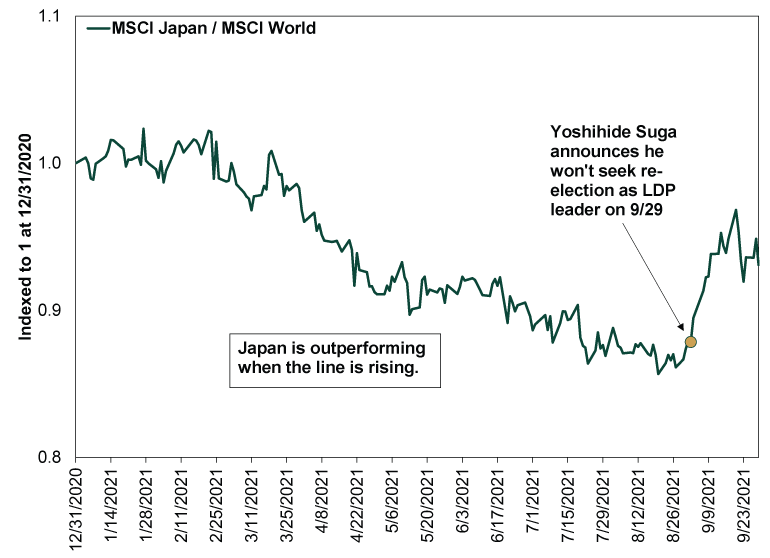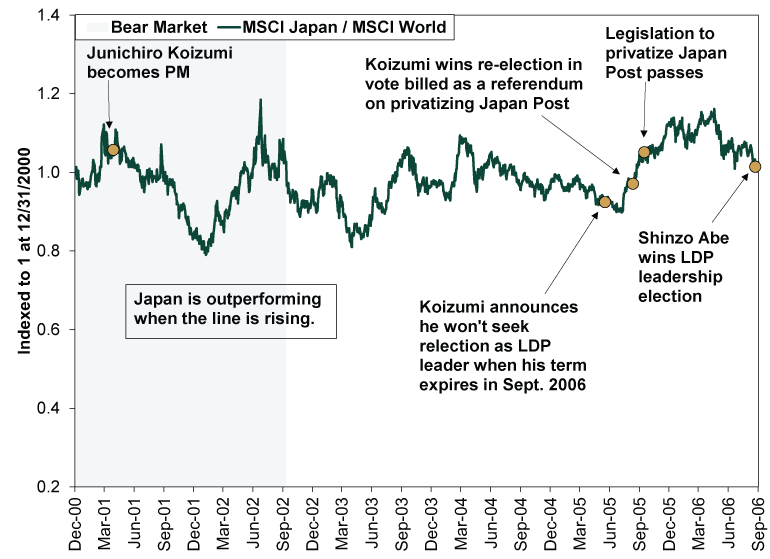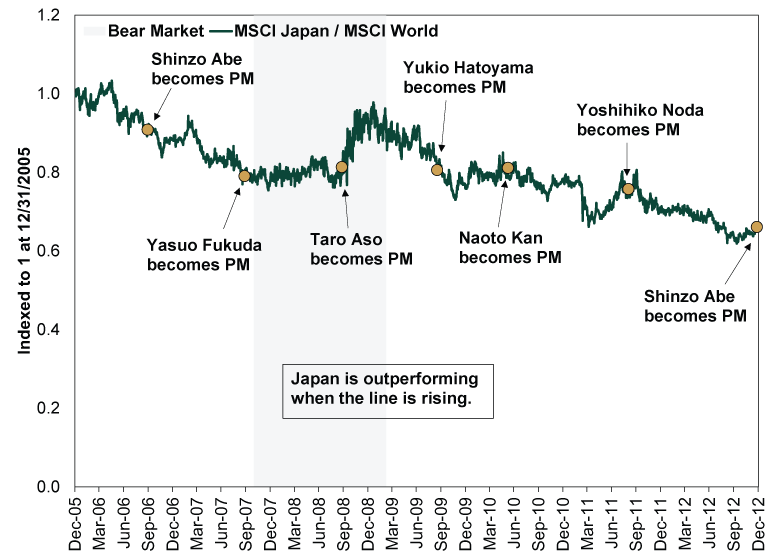Personal Wealth Management / Politics
Sunset on Reform Hopes in Japan?
Japan’s new prime minister likely extends the status quo for stocks.
Editors’ Note: MarketMinder is politically agnostic. We favor no politician nor any party and assess political developments for their potential economic and market impact only.
Japan officially has a new prime minister (PM) in waiting, and it is … not the person observers expected. Heading into today’s Liberal Democratic Party (LDP) leadership vote, reform minister Taro Kono was the apparent favorite, but former LDP Research Council chair Fumio Kishida pulled off an upset with unexpectedly strong support from LDP lawmakers. Presuming he wins a confidence vote in Japan’s parliament (known as the Diet) on October 4—a foregone conclusion, considering the governing coalition’s supermajority—he will become the next PM and form the country’s 100th government. Japanese stocks fell sharply on Wednesday, dipping -1.9% on the day, perhaps partly due to this news.[i] We wouldn’t be surprised to see a bit of Japanese lag persist, either. To us, investors seemed to get too far out over their skis on economic reform hopes when Kono looked like the heir apparent. But now it is Kishida and reality is setting in.
When former PM Yoshihide Suga announced on September 3 that he wouldn’t seek re-election as LDP chief in today’s election, Kono swiftly emerged as the likely successor. While stocks in the rest of the world hit a speedbump, Japanese markets rallied on the prospects of change. In his short tenure as PM, investors mostly saw Suga as a classic safe pair of hands—a name well known in Japan and a PM who would focus on shepherding the country through COVID rather than rock the boat with contentious reforms. In most developed countries, that sort of gridlock and status quo is generally bullish, as “reforms” create winners and losers. But Japan remains plagued by a number of structural issues that stifle competition and domestic demand, including a byzantine labor code and complex web of cross-shareholdings among the major conglomerates. Throughout Japan’s post-War history, this system has kept bloated, hopeless companies afloat and stifled competition from new challengers. It is a big reason for the country’s infamous lost decades in the 1990s and 2000s.
No one expected Suga to act on any of this, especially as successive COVID lockdowns, a controversial Olympic games and Japan’s delayed vaccine rollout sapped his political capital. But when he stepped aside and Kono took center stage, sentiment flipped fast. Kono was popular. He championed reforms. He seemingly had the clout and charisma of Junichiro Koizumi and Shinzo Abe, the only recent Japanese PMs that pulled off some reforms (and had any staying power in office). Anticipating his victory and a raft of pro-market changes, Japanese stocks jumped 6.9% in the week and a half after Suga’s announcement, making up much of their year-to-date lag versus global markets. Headlines globally salivated over more, pointing to international fund flows and reform rumors.
Exhibit 1: High Hopes and Japanese Outperformance

Source: FactSet, as of 9/29/2021. MSCI Japan and MSCI World Index returns with net dividends, 12/31/2020 – 9/29/2021.
In our view, this rally likely would have proved irrational whether or not Kono won. Investors have long gotten too starry-eyed over potential Japanese reformers, underestimating the deep resistance to change. The LDP’s powerful rural wing, for example, has long counterbalanced leadership’s free-trade stance. The labor code and culture of lifetime employment are a political third rail. Even Abe and Koizumi, for their successes, encountered opposition and failed to fulfill key pledges. Koizumi did clean up Japan’s banking system in the early 2000s, finally addressing the legions of zombie banks that had dogged the country’s economy since the Nikkei bubble burst. But the effort to privatize Japan Post, as beneficial as we think it was, monopolized the rest of his term, leaving other issues by the wayside. Over his entire term, Japanese stocks performed roughly in line with the world, as spells of leading and lagging canceled each other out.
Exhibit 2: Koizumi Wasn’t as Bullish as Everyone Remembers

Source: FactSet, as of 9/29/2021. MSCI Japan and MSCI World Index returns with net dividends, 12/31/2000 – 9/30/2006.
When Abe succeeded Koizumi after he termed out as LDP leader in September 2006, investors maintained high hopes for reform. The privatization of Japan Post was in progress, and Abe, as Koizumi’s hand-picked successor, had a similar reform agenda. Or so everyone thought. In reality, his chief ambition proved to be amending Japan’s Constitution to remove the anti-war clause and restore the country’s military might. That hogged most of his attention, leaving a goose egg when he stepped down for health reasons a year later. But in late 2012, he mounted a comeback, reviving reform hopes. When he became Japan’s Grover Cleveland in late December 2012, the LDP and its coalition partner, the pacifist New Komeito party, had a supermajority in the lower house—theoretically giving him the clout to pull off what Koizumi couldn’t.
Japanese stocks rallied on high hopes as Abe’s “Abenomics” agenda topped headlines globally with its “three arrows” of monetary stimulus, fiscal stimulus and economic reforms. Abe even had a few successes on the latter front, including a handful of free-trade agreements and significant corporate tax cuts. But reforms eventually took a back seat as constitutional change returned to the fore, again draining attention and political capital. After outperforming significantly during Abe’s honeymoon period, Japanese stocks soon paralleled investors’ dashed hopes. By 2014, they were underperforming cumulatively since Abe’s election, and they would keep doing so over the rest of his long tenure.
Exhibit 3: Abe’s Honeymoon Period Was Short

Source: FactSet, as of 9/29/2021. MSCI Japan and MSCI World Index returns with net dividends, 6/30/2012 – 12/31/2014.
When Suga announced he would step down, we asked readers a simple question: What was the likelihood Kono (or whoever) could pull off major changes that Abe and Koizumi couldn’t? Our answer, in a nutshell, was “low.” Thinking otherwise was essentially a this time is different argument, which are always the most dangerous words in investing. This isn’t a we told you so, mind you, but a reminder to think critically and not get taken in by headline hype, lest you chase heat and get burned. Had Kono won, there was a risk Japan would outperform for a while longer as irrational hopes inflated, but the likelihood relative returns followed their general path under Abe—and faltered as reform hopes faded—seemed high.
As for what comes next, Kishida was largely the status-quo candidate during the LDP leadership contest. He championed big fiscal stimulus, rather than reform. Fiscal stimulus always sounds nice, but multiple administrations have thrown stimulus at Japan’s economy during this millennium, without much to show for it. The result is public spending and investment representing an outsized share of GDP relative to the US and elsewhere—not a dynamite economy.
More broadly, it looks to us like Japan’s infamous revolving door of PMs may be back. If you set the over/under for Kishida’s tenure at one and a half years, we would probably take the under.[ii] Not because of anything unique to him, but because that is the norm when Japan selects a status quo-type candidate that churns out of the country’s political machine. Between Koizumi and Abe’s second turn at the wheel, Japan had six PMs in six years. During this stretch, the only notable burst of outperformance happened during the global financial crisis, when Japanese stocks fulfilled their traditional, defensive role. Otherwise and overall, the revolving door was decidedly not bullish.
Exhibit 4: The Revolving Door Didn’t Make Stocks Soar

Source: FactSet, as of 9/29/2021. MSCI Japan and MSCI World Index returns with net dividends, 12/31/2005 – 12/31/2012.
Therefore, we think it is most beneficial to view Japan as we long have: a place where big multinationals are likely to outperform domestically oriented companies that would benefit most from reforms. In that regard, Japanese stocks have plenty to offer from a diversification standpoint, but we don’t think the country should be the centerpiece of a global portfolio for now.
If you would like to contact the editors responsible for this article, please message MarketMinder directly.
*The content contained in this article represents only the opinions and viewpoints of the Fisher Investments editorial staff.
Get a weekly roundup of our market insights
Sign up for our weekly e-mail newsletter.

You Imagine Your Future. We Help You Get There.
Are you ready to start your journey to a better financial future?

Where Might the Market Go Next?
Confidently tackle the market’s ups and downs with independent research and analysis that tells you where we think stocks are headed—and why.





